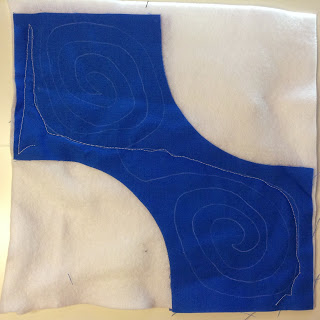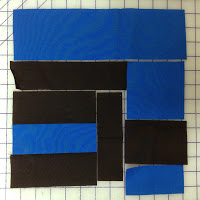Josh’s Quilting Tip #7
Our tip today follows last week‘s where I discussed the importance of daily practice.
When looking for a quilt block to practice on, I had an idea. Why free motion quilt on a square block? Why not try any scrap shape like a polygon? I’m always seeing random cut up shapes on Leah’s table and I was curious why she doesn’t quilt on them.
The idea intrigued me, but Leah quickly informed me this wouldn’t work. Color me even more intrigued. When I asked why, she said it was something quilters just didn’t do. Apparently we quilt on squares or quilt tops. When I heard that, I knew I had try.
I came up with the idea while looking at various scrap fabrics laid out on the table. Some shapes were so wonky it was clear they were just destined for the trashcan. I also thought it would be cool and different to try free motion quilting on an unusual shape.
Here is the shape I chose…

…as you can see, this didn’t work out at all.
I couldn’t get comfortable with the piece, no matter what direction I stitched from or how I placed my hands. I even tried marking a spiral shape, but it was a no go. My stitching was all over the place. The piece was simply a disaster on every level.
What I learned: at least for a beginner, you really need a solid shape like a square or rectangle. In the future I do plan on trying to free motion quilt on some type of polygon, but it has to be a solid geometrical shape, not the random mess pictured above.
All in all, it was an interesting experiment, especially hearing Leah’s reaction to my initial idea!
Until next week, let’s go quilt.
Josh

Leah’s note: From the sound of this post, I might be headed for a nomination to the Quilting Police! In my defense, I just couldn’t understand why Josh would want to quilt a scrap shape – what in the world will you do with it later?
Also just because Josh couldn’t quilt on that random scrap above doesn’t mean scraps are totally off limits. You just need to piece them together to make a square or rectangle big enough to hang onto and move smoothly under your needle.
Another bonus of using a square or rectangular shape – they’re easier to connect together to turn into something usable. Yes, even practice blocks can be turned into real quilts!

Te dejo un fuerte abrazo esperando que esta Navidad y Año Nuevo estén colmado de bendiciones para ti y tus seres queridos, me voy de vacaciones!!!
cariños,
Ale
Costa Rica
Good on you for trying! If you don't try how do you know if it is something that will work or now? Trying new things is good. It is the mother of invention!
I don't know if this posed before–if so, I apologize for the double post. I said that you could have quilted that shape if you had put a layer of tulle over it first. Also, you could have done it easily with the tulle and a hoop. It was the raw edges that messed you up, not the shape necessarily.
Sally in Seattle
MAYBE you should try sewing the edges down as RAW EDGE applique… that would keep the block pieces in better control while you quilt on the pieced portion of the block then you can FMQ any pattern you want. RAW EDGE APPLIQUE is how many art quilts are done. YOu can also use fusible to tack down the scrap pieces but that sometimes gets kind of stiff. THE SECRET to quilting is CONTROL what you are doing on the sewing machine…. Keep up trying.